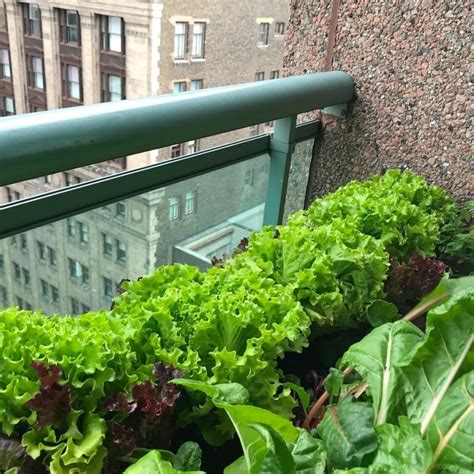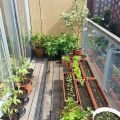Grow Fresh and Healthy Salad Greens on Your Balcony: A Complete Guide
Introduction
In recent years, more people have embraced balcony gardening as a way to enjoy fresh, homegrown produce without needing a large yard. Growing salad greens on your balcony offers a practical solution for urban dwellers who want to incorporate green living into their lifestyle. This guide explores how to grow your own salad on a balcony, from choosing the right containers and soil to maintaining healthy plants, even in small spaces.
Key Concepts
- Balcony Gardening: Growing plants in small, outdoor spaces such as balconies, often using containers or vertical arrangements.
- Container Gardening: A method where plants are grown in containers instead of directly in the ground, ideal for small space gardening.
- Urban Gardening: A practice that involves cultivating food plants within city environments, allowing for homegrown produce in limited spaces.
- Salad Greens: A category of edible leafy vegetables such as lettuce, arugula, spinach, and kale, commonly used in fresh salads.
Historical Context
The idea of growing food in small urban spaces isn’t new. Victory gardens during World War II were popular as a way for citizens to contribute to the war effort. Urban gardening saw a resurgence during the 21st century, particularly during the pandemic when people looked for self-sustaining practices like balcony gardening to enhance food security and reduce grocery trips. Today, the trend continues as more individuals seek ways to grow fresh food in cities.
Current State Analysis
Salad gardening on balconies has become more feasible thanks to advancements in container design, compact varieties of plants, and improved soil blends. Increasing interest in sustainable living has made it a popular hobby. However, urban challenges like limited sunlight, space constraints, and air quality still pose obstacles. Despite these, many gardeners find that they can produce sufficient salad greens to enjoy several fresh meals per week.
Practical Applications
- Choosing Containers: Opt for containers with good drainage and a depth of at least 6 inches for salad greens. This helps prevent waterlogging, which can damage roots.
- Soil Selection: Use a high-quality potting mix designed for vegetables. Consider adding organic matter like compost to improve nutrient content.
- Sunlight Requirements: Most salad greens require 4-6 hours of sunlight per day. Choose a spot on your balcony that gets ample light or use grow lights if necessary.
- Watering Techniques: Keep the soil consistently moist but not waterlogged. Water in the morning to allow leaves to dry throughout the day, reducing the risk of fungal infections.
Case Studies
| Gardener | Balcony Size | Salad Varieties | Yield | Challenges |
|---|---|---|---|---|
| Alice | 4 x 8 ft | Lettuce, Arugula, Spinach | 3-5 servings/week | Limited sunlight in winter |
| Ben | 6 x 6 ft | Kale, Romaine, Mixed Greens | 5-7 servings/week | Dealing with pests like aphids |
| Clara | 4 x 6 ft | Microgreens, Spinach, Chard | 4 servings/week | Wind exposure drying out soil |
Stakeholder Analysis
Several stakeholders benefit from increased balcony gardening. Urban residents gain access to fresh food and a satisfying hobby, while city planners can incorporate green spaces into urban design. Environmental groups support balcony gardens as a way to promote sustainability and reduce the carbon footprint associated with transporting food. However, landlords may need to address concerns over balcony weight limits and proper drainage to prevent property damage.
Implementation Guidelines
- Step 1: Plan Your Space – Measure your balcony and decide how many containers can fit. Leave space for easy access and plant care.
- Step 2: Select Seeds and Varieties – Choose fast-growing salad greens like arugula and lettuce for continuous harvesting. Opt for heat-tolerant varieties if your balcony gets strong sun.
- Step 3: Prepare Containers – Fill each container with a blend of potting soil and organic matter. Ensure drainage holes are clear.
- Step 4: Planting – Sow seeds according to packet instructions, typically at a depth of 1/4 inch. Space them to avoid overcrowding.
- Step 5: Maintenance – Water regularly, keep an eye on pests, and rotate containers for even sunlight exposure.
- Step 6: Harvesting – Use a pair of scissors to cut leaves when they reach the desired size, allowing the plants to regrow for multiple harvests.
Ethical Considerations
While balcony gardening provides many benefits, ethical considerations include the responsible use of water and avoiding chemical fertilizers that can harm local ecosystems. Additionally, choosing non-GMO and organic seeds can ensure that your homegrown produce aligns with sustainable practices.
Limitations and Future Research
- Space Constraints: Not all urban dwellers have access to balconies, which limits participation in home gardening. Research into vertical gardening techniques and indoor gardening options could expand access.
- Pest Management: Further study is needed to find non-toxic, balcony-friendly pest management solutions to minimize the impact on surrounding environments.
- Climate Adaptation: With changing weather patterns, future research should explore plant varieties that can thrive in diverse urban climates and handle temperature fluctuations.
Expert Commentary
According to gardening experts, the future of urban gardening lies in integrating technology like smart irrigation systems and self-watering containers to make balcony gardening more accessible to beginners. At the same time, experienced growers emphasize the value of connecting with nature, even in the midst of a cityscape. As demand for homegrown produce continues to rise, mastering the art of growing salad on your balcony can transform even the smallest spaces into a productive, green oasis.


